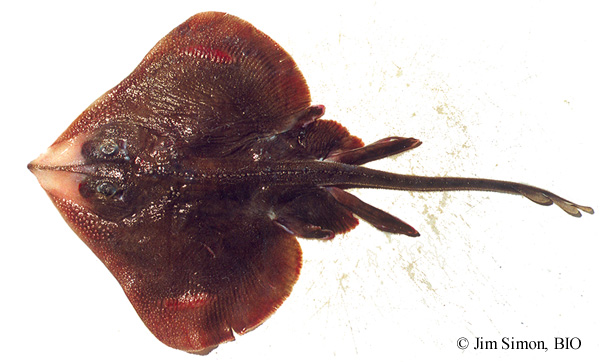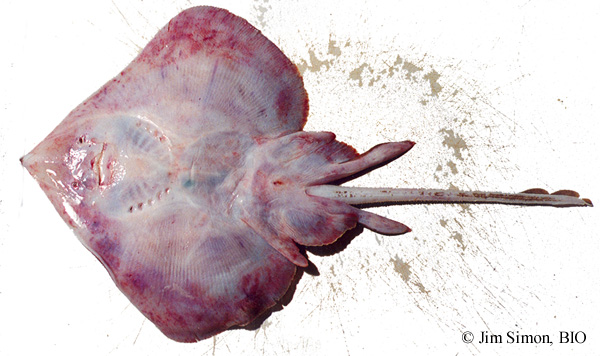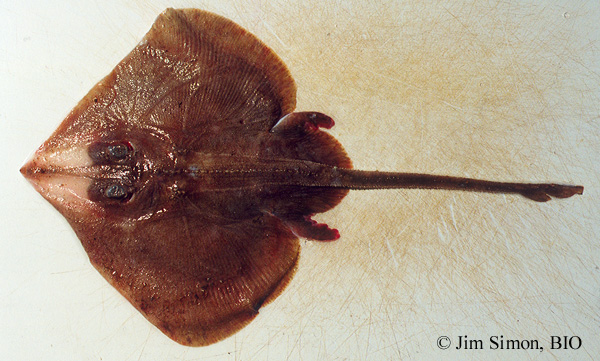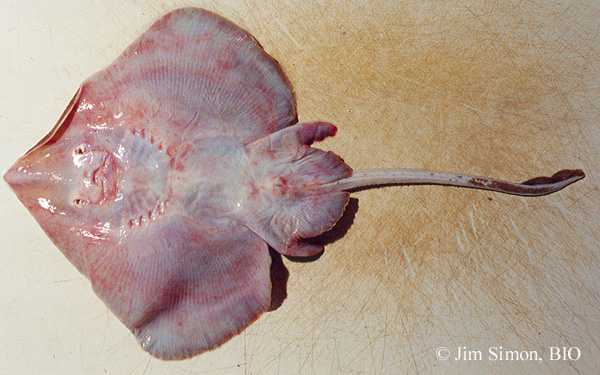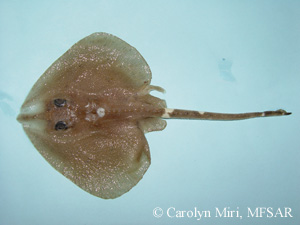Smooth Skate
Malacoraja senta
Description
The smooth skate has a depressed body, a slender tail, a disc approximately 1.2 x as broad as it is long, a relatively pointed snout with an anterior angle of about 110°, and a tail with inconspicuous, narrow, lateral folds on the posterior two-thirds. Teeth number 38 - 40 series in the upper jaw and 36 - 38 in the lower jaw, and are sharper in males than in females, whose teeth have low cusps. The entire upper surface of the disk in immature smooth skate is evenly roughened with small prickles which are also present on the pelvics and the tail. Older specimens have irregular smooth areas on the shoulders and upper pelvic fins. The thorn pattern of the smooth skate is distinct, with 16 or more medium thorn-like spines beginning a short distance behind the spiracles and running along the midline of back, and 20 to 30 smaller spines along the midline of the front half of tail. There are also 10 to 15 spines around the inner edge of each eye, and 3 to 5 spines on each shoulder, in both sexes. Mature male smooth skate have several rows of hooked, erectile spines on the outer margins of both pectorals (termed alar spines). The underside of the disc is smooth except for a few prickles near the snout on mature specimens. Smooth skate have two dorsal fins similar in size and shape and confluent at their bases, located near the end of the tail; a caudal membrane about half the length of the second dorsa fin; and pectorals overlapping the pelvics, which are bi-lobed with a noticeably narrower anterior lobe separated from the posterior by a deep, scalloped notch. The claspers of mature males reach slightly more than half the distance from the axils of pelvics to the first dorsal. The upper surface of the smooth skate is pale brown with numerous, faint, darker spots, and the lower surface is white, often with dusky spots. The tail is whitish below, often with distinct dark-blotches, and the posterior third is sometimes uniformly dark. Young smooth skate are easily distinguished by the two transverse pale bars on the tail, each outlined by a dark crossbar in front and behind, which are lost during growth.
Size
The smooth skate is among the smallest species of skate in northwest Atlantic waters. It reaches a maximum length of approximately 57.7 cm to 61 cm.
Range
The smooth skate is a boreal species occurring only in the northwest Atlantic Ocean from the St Lawrence River estuary, the Gulf of St Lawrence and the Labrador Shelf to as far south as South Carolina. It is commonly encountered on the southern Grand Bank along the Scotian Shelf to the Bay of Fundy - Georges Bank - Gulf of Maine region.
Habitat
The smooth skate is a benthic species living on clay, silt or soft sand bottoms predominantly in deep troughs and basins (> 110 m). It has a narrower depth range (31 - 874 m) and overall temperature range (0.5 - 10°C) than the thorny skate (Amblyraja radiata), with which it shares its distribution.
Life History
Recent studies on age, growth and maturity in smooth skate have demonstrated that despite its relatively small size, this species is slow-growing, late-maturing and long-lived, and is therefore vulnerable to decline due to over-exploitation. Of particular concern is the late age at maturity reached by females relative to the maximum age, leaving very few egg-producing years for each individual female. For more information on how life history characteristics are determined in NW Atlantic skate, go to the Skate Research section of this website or refer to the references listed in the table below.
Diet
The smooth skate is sympatric with the thorny skate (Amblyraja radiata) throughout its range, and is thus in food competition with the later. However, resource competition is thought to have driven food specializations in the smooth skate, which feeds almost exclusively on epifauna, such as decapod crustaceans and euphausiids. Mysids are also of greater importance to smooth skate than to thorny skate.
Reproduction
Smooth skate are capable of reproduction year-round, with no appreciable peaks in reproductive activity both in the Gulf of Main and on the eastern Scotian Shelf. Size at hatching is not known, but free-swimming skates 9.5 cm TL and larger (with internal yolk sacs) have been found on the eastern Scotian Shelf, suggesting an average hatching size less than 10.0 cm TL. For a look at the egg capsules of the smooth skate, click on the link Identification of NW Atlantic Skate Egg Capsules.
Interaction with people
Although the smooth skate is one of the most common species encountered in Atlantic Canada waters, it is seldom used when captured, mostly due to its relatively small size. Instead, smooth skate caught as bycatch by fisheries targeting other species are usually discarded. It is not known how many smooth skate are discarded annually, nor what the discard mortality of these fish is. Occasionally, smooth skate are used as "trash fish" in the manufacture of fish meal and pet food. In the Gulf of Maine, the thorny skate is regarded as over-fished, and commercial landing of this species is now prohibited.
Common Names
Also called "smooth-tailed skate" or "prickly skate".
- Date modified:
